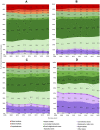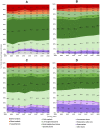Trends in food and beverage purchases in informal, mixed, and formal food outlets in Mexico: ENIGH 1994-2020
- PMID: 37293617
- PMCID: PMC10244666
- DOI: 10.3389/fpubh.2023.1151916
Trends in food and beverage purchases in informal, mixed, and formal food outlets in Mexico: ENIGH 1994-2020
Abstract
Background: The retail food environment in Mexico is characterized by the co-existence of both, formal and informal food outlets. Yet, the contribution of these outlets to food purchases over time has not been documented. Understanding the longitudinal trends where Mexican households purchase their foods is critical for the development of future food retail policies.
Methods: We used data from Mexico's National Income and Expenditure Survey from 1994 to 2020. We categorized food outlets as formal (supermarkets, chain convenience stores, restaurants), informal (street markets, street vendors, acquaintances), and mixed (fiscally regulated or not. i.e., small neighborhood stores, specialty stores, public markets). We calculated the proportion of food and beverage purchases by food outlet for each survey for the overall sample and stratified by education level and urbanicity.
Results: In 1994, the highest proportion of food purchases was from mixed outlets, represented by specialty and small neighborhood stores (53.7%), and public markets (15.9%), followed by informal outlets (street vendors and street markets) with 12.3%, and formal outlets from which supermarkets accounted for 9.6%. Over time, specialty and small neighborhood stores increased 4.7 percentage points (p.p.), while public markets decreased 7.5 p.p. Street vendors and street markets decreased 1.6 p.p., and increased 0.5 p.p. for supermarkets. Convenience stores contributed 0.5% at baseline and increased to 1.3% by 2020. Purchases at specialty stores mostly increased in higher socioeconomic levels (13.2 p.p.) and metropolitan cities (8.7 p.p.) while public markets decreased the most in rural households and lower socioeconomic levels (6.0 p.p. & 5.3 p.p.). Supermarkets and chain convenience stores increased the most in rural localities and small cities.
Conclusion: In conclusion, we observed an increase in food purchases from the formal sector, nonetheless, the mixed sector remains the predominant food source in Mexico, especially small-neighborhood stores. This is concerning, since these outlets are mostly supplied by food industries. Further, the decrease in purchases from public markets could imply a reduction in the consumption of fresh produce. In order to develop retail food environment policies in Mexico, the historical and predominant role of the mixed sector in food purchases needs to be acknowledged.
Keywords: food outlets; food purchases; households; informal food outlets; retail food environment.
Copyright © 2023 Domínguez-Barreto, Farah, López-Olmedo, Perez-Ferrer, Ramírez-Toscano, Barrientos-Gutiérrez and Stern.
Conflict of interest statement
The authors declare that the research was conducted in the absence of any commercial or financial relationships that could be construed as a potential conflict of interest.
Figures




Similar articles
-
Changes in the healthfulness of food and beverage purchases from 2006 to 2022 by outlet type in Mexico.BMC Med. 2025 Apr 7;23(1):205. doi: 10.1186/s12916-025-04036-8. BMC Med. 2025. PMID: 40189521 Free PMC article.
-
Food and beverage purchases at formal and informal outlets in Mexico.Public Health Nutr. 2023 May;26(5):1034-1043. doi: 10.1017/S1368980022002324. Epub 2022 Oct 26. Public Health Nutr. 2023. PMID: 36285524 Free PMC article.
-
Mexican Households' Purchases of Foods and Beverages Vary by Store-Type, Taxation Status, and SES.Nutrients. 2018 Aug 8;10(8):1044. doi: 10.3390/nu10081044. Nutrients. 2018. PMID: 30096817 Free PMC article.
-
A systematic review of the implementation of healthy food retail interventions in settings with multiple food retail outlets (complex food retail settings).J Nutr Sci. 2024 Sep 18;13:e31. doi: 10.1017/jns.2024.52. eCollection 2024. J Nutr Sci. 2024. PMID: 39314531 Free PMC article.
-
A Scoping Review of Studies Evaluating the Healthiness of Street Food Vendors.Curr Nutr Rep. 2023 Dec;12(4):893-908. doi: 10.1007/s13668-023-00510-y. Epub 2023 Dec 8. Curr Nutr Rep. 2023. PMID: 38064169
Cited by
-
Changes in the healthfulness of food and beverage purchases from 2006 to 2022 by outlet type in Mexico.BMC Med. 2025 Apr 7;23(1):205. doi: 10.1186/s12916-025-04036-8. BMC Med. 2025. PMID: 40189521 Free PMC article.
-
Urban Environments, Health, and Environmental Sustainability: Findings From the SALURBAL Study.J Urban Health. 2024 Dec;101(6):1087-1103. doi: 10.1007/s11524-024-00932-1. Epub 2024 Nov 25. J Urban Health. 2024. PMID: 39587001 Free PMC article. Review.
-
Changes in sugar-sweetened beverages and non-essential energy-dense food purchases overall and by type before and after the implementation of taxes in Mexico: repeated cross-sectional national surveys (2008-2018).BMJ Public Health. 2025 May 30;3(1):e001524. doi: 10.1136/bmjph-2024-001524. eCollection 2025. BMJ Public Health. 2025. PMID: 40521336 Free PMC article.
References
-
- Turner C, Aggarwal A, Walls H, Herforth A, Drewnowski A, Coates J, et al. . Concepts and critical perspectives for food environment research: a global framework with implications for action in low- and middle-income countries. Glob Food Sec. (2018) 18:93–101. doi: 10.1016/j.gfs.2018.08.003 - DOI
-
- Downs SM, Ahmed S, Fanzo J, Herforth A. Food environment typology: advancing an expanded definition, framework, and methodological approach for improved characterization of wild, cultivated, and built food environments toward sustainable diets. Foods. (2020) 9:532. doi: 10.3390/foods9040532, PMID: - DOI - PMC - PubMed
Publication types
MeSH terms
Grants and funding
LinkOut - more resources
Full Text Sources

